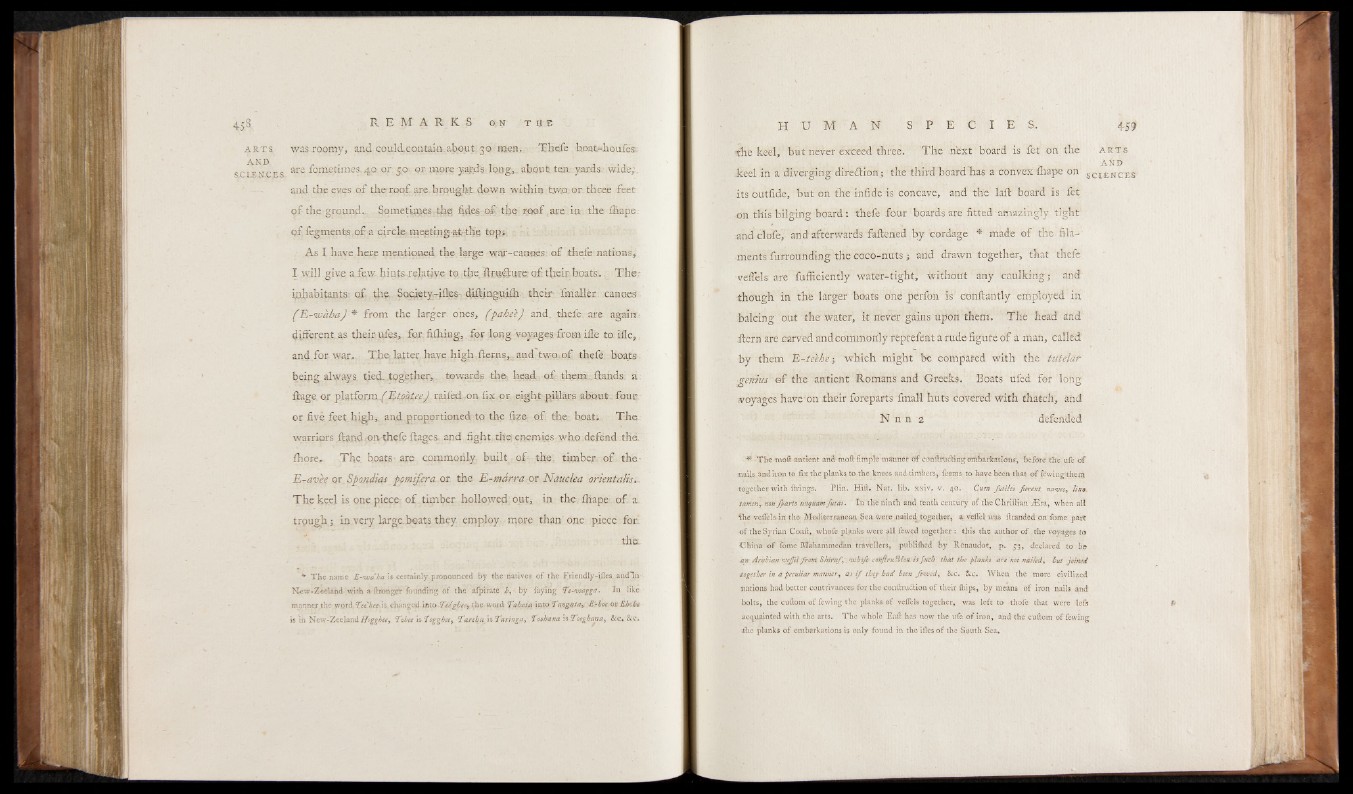
a r t s was roomy, and;cou;ld,conttin.aböut30 men,. Thefe hoat-houfe's;
s£E&NCES are fometimes.40 or ^o1 or more yard’s long,, about ten yards wide^,
and the eves o f the-roof are. brought down within tw-a.or three feet
o f the ground- Sometimes the tides o f the roof are in the lliupe
o f fegments o f a circle,.meptingtB^th'g tops
As I have here mentioned the, large war-canoes, o f thefe nations,
I wall give a.few hintsTelatiye to :thetftriu#ure: ofi their.boats.. Th e -
iflbabitants of, the, Saqiety-ifles- diihnguifh their fmallér. canoes
(E - ■ waba) * from the larger, ones, fpaheij and. thefe. are again'■.
different, as their ufe.s, for. fifhing,. for long-voyages-from ifle to iile ,.
and.for- war, T h e latter. have high Herns,,and .two,of thefe. boats,
being always tied..together,. towards the- head, o f them hands a.
flage or platform .fEtMtee.) raife.d on fiy.or. eight pillars about- four
or five feet, high, and proportioned to the fize of: the boat. The.
warriors ffand.-on-thefe ftages- and fight, the-enemies who. .defend the.
fhore- T h e boats,■ are commonly, built of- the. timber o f the-
E-avee or Spondias poraifera. or the E-mdrra or Nauclea orientate...
T h e keel is one piece o f timber hollowed out, in the fhape o f a
trough; in very large.beats they, employ more than one piece fori
the.
* The name E-wa'ha is certainly pronounced by the natives of the Friendly-ifies. andln
New-Zeeland with a ftronger founding of the afpirate b, by faying Te-wagga. In like
manner, the. y/grd Teehee is. changed into Tee'ghee, the word Tabata into Tan gat a_, E-hoe or Eht.be
is in New-Zeeland Hogghee, Tabee is Toggbee, Tarcba h Taringa, To oh an a is Tooghana, &c. &c.
the k e e l , but n e v e r exceed three. Th e n e x t board i s fet o n the a r t s
.............. A N D
,keel in a diverging diredfion; the third board has a convex fhape on SCIENCEs
its outfide, but on the infide is concave, and the laft board is fet
on this bilging hoard: thefe four boards are fitted amazingly tight
.and clofe, and afterwards fattened by cordage * made of the filaments
furrounding the coco-nuts; and drawn together, that thefe
veffels are fufficiently water-tight, without any caulking; and
though in the larger boats one perfon i ! ’ conftantly employed in.
haleing out the' water, it never gains upon them. The head and
•ttern are carved and commonly reprefent a rude figure o f a man, called
by them E-teehe.-, which might be compared with the tutelar
■ genius o f the antiefit Romans and Greeks. Boats ufed for long
•voyages have-on their foreparts final! huts covered with thatch, and
N n t l defended
-* The moft antrent andmoft fimpie manner of cdnftru&ng embarkation?, before the ufe of
nails and iron to fix the planks to the knees and timbers* feems to have been that of fe'wing then*
together with firings. Plin. Hift. Nat. lib. xxiv. v. 40. . C u m fu t ile 's fie r en t n a v e s , lin o
tatrlcn,. ta n fp a r io unquam fu t a s . In the ninth and tenth century of the Chrifiian iEra, when alt
the veffels in the Mediterranean Sea were nailed together, a veffel was ftcanded on fome part
o f the Syrian Coaft, whofe planks were all fewed together : this the author of the voyages to
China of fome MaHammedan travellers, pubhfhed by Renaudot, p. 53, declared to bo
a n A r a b ia n v e ffe l f r o n t S h i r a f w b o fe cotoflruZiiou is f t t c b th a t th e p la n k s a r e not n a iled , b u t jo in e d
to g e th e r in a p e cu lia r m a n n er , a s i f they h a d been J ew e d , &c. See. When the more civilized
nations had better contrivances for the conftnuStion o f their Ihips, by means of iron nails and
bolts, the cuftom of fewing the planks of veffels together, was left to thole that were lefs t»
acquainted with the arts. The whole Eaff has now the life of iron, and the cuftom of fewing
she planks of embarkations is only found in the ifies of the South Sea.